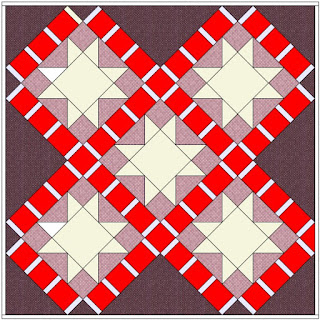Gretchen's madder repro star.
The background might be classified as either a coral print or a stick print.
A shawl print imitating woven design.
I could go on about quirky print fads in the early-19th-century but this has got to stop somewhere! Here's the LAST star post in the Time Warp Quilt Along. We'll end with three related designs typical
of early 19th century roller prints from about 1810-1840.
Shawl Prints
The design influence of India's cashmere shawls was impressive. From them we get the classic paisley prints, which were first called shawl prints.
European printers borrowed the boteh shape. They also imitated
the expensive woven shawl look by stylizing shapes to look
like they are woven. Notice the diagonal lines and the jagged edges.
A twill shawl print designed to look like it is woven
rather than printed.
Shawl prints did not necessarily have the botah shape we
associate with paisley prints.
From a quilt about 1810. The jagged edges could be quite strange.
A small florette (#1) a shawl print from Ackermann's Repository about 1810.
Note the tiny printed lines
to further the illusion. The lines echo a twill weave.
Another issue of Ackermann's Repository with a form of shawl print style at top.
Shawl print (lower left) and a mossy trail or coral (upper right)
Stick Prints & Cracked Ice
The fashionable jagged look is also seen in two relatives: Stick prints and cracked ice, also probably derived from Eastern imports to Europe.
Odd relations about 1830: stick prints and cracked ice.
Stick print for the light at the top here
Cracked ice for the light at the lower right.
Stick prints might be seen as moss or seaweed but
are exaggerated in their angularity.
They resemble a Japanese porcelain pattern called Prunus or Hawthorn.
A plum tree design
The blue stripe is a stick print that would never grow in nature.
A shawl print with a stick print.
Stylized paisley with green sticks.
Too buggy for me!
Cracked Ice or Thorn Prints
In the 1960s textile historian Peter Floud mentioned “cracked ice” as a style often seen in quilts from the second quarter of the 19th century. The spiky vines or thorns seem to be a cross between seaweed and stick prints.
Thorns or cracked ice.
Cracked ice as a fancy machine ground

The lower pink and white print---cracked ice?
Mimimalism in the 1830s.
The source for cracked ice as with the stick flowers may very
well be the European fascination with Asian porcelain. Above a Japanese
vase from about 1710 described by dealer Polly Latham as:
"A classic Kangxi period blue and white yen-yen vase decorated in the 'Cracked Ice and Prunus' pattern."
Read more about cracked ice here:
Reproductions
A stripe from French General
You may have some reproductions that imitate woven pattern,
forms of the shawl print
Stick prints and cracked ice are going to be harder to find.
From Terry Thompson's Louisa line a few years ago.
From Moda's Mill Book 1852.
Cracked ice?
SF's star center fits right in here.
These last categories are going to be in short supply in your stash or your shop.
But now you have new shopping goals.
What to Do With Your Stack of Stars?
Use Them for Sashing

Sandy Klop and her Oh! My Stars quilt.
Here's an ambitious plan.
You could set all your six-inch stars into sashing for a larger star.
Above: An antique quilt
(All I can find out is that it's attributed to Camden County, New Jersey.)
Below: Sandy's pattern for American Jane
94" x 94"
This amazing pattern has won quilters
some prizes since Sandy published it a few years ago.
Scroll down to the middle to see the pattern.
Here's Patricia Dear with her Best in Show.
A little Photoshopping
You could take 117 of your 6" stars and turn
them into the same sashing for a 24" star. You might want to choose
a simple star for that large star.
My EQ7 sketch shows you how to piece the sash.
Each red square is a 6 finished star. Cut the light colored
sash rectangles 2" x 6-1/2"
You'll be making strips that finish to 24" x 6."
Use a 6" star for the cornerstones between sashing.
This sketch is a little out of scale but each red square is
a 6" star. I drew it up in EQ7 and it tells me the finished
quilt will be about 127" square.
Sandy used a smaller setting star since her finished quilt
with its dog tooth border is 94" square
Maybe you have more use for a quilt that's about 84" square.
But this one only uses 52 of your 6" stars.
You could set everything on the square grid.
Nine big stars finishing to 24"
and 88 small stars finishing to 6".
It's ONLY 90"
You could also reduce the size by omitting the little sashing strip on the original.
Piece three 6" stars together into 18" finished sashing strips.
Your large star would then be 18".
Each of those small squares is a 6" star.
I think you are still using 117.
98" x 98"
Another option: set 2 stars in strips that sash finished 12" stars.
One Last Thing About Early Roller Print Styles
Nine patch from about 1890
Notice the lilac cracked ice in the center strip at left and right.
Designers have been reproducing old looks for a long time.
The 1870-1910 era is full of repro styles in new shades.
Next Week: More Sets




















































